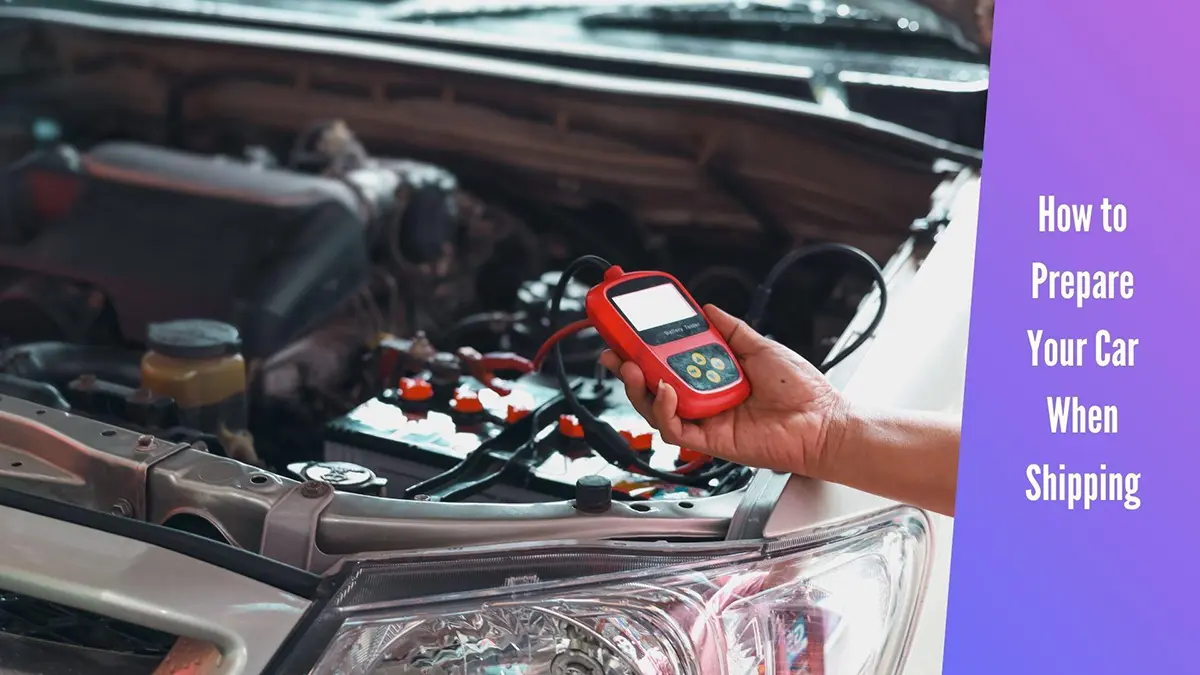Shipping your car can be a stressful experience. You want to make sure your vehicle arrives safely at its destination. But before you take the plunge, you wonder what to know when shipping a car. Well, the one key thing is proper preparation before transporting your car. Today, we’ll offer tips on how to get your vehicle ready for shipping.
Whether you are moving cross-country and need car transport or just shipping your car to a new location, follow these guidelines to ensure a smooth process.
What to Know When Shipping a Car - Some General Considerations:
1. Choosing a Shipping Company
The first thing you want to prioritize is to research and select a well-rated car shipping company thoroughly. Consider their reputation, experience, services, liability coverage, and customer reviews. Companies like Easy Auto Ship are often recommended for their reliable service.
2. Method of Transportation
Two standard transportation methods are open carriers and enclosed carriers. The former is cheaper, but your car is exposed to weather elements; the latter offers more protection but is pricier. An economy-class sedan might be suited for an open carrier, while a luxury, vintage, or exotic car should use an enclosed carrier.
3. Cost
Understand that the cost of shipping a car can vary from a few hundred dollars to over a thousand depending on factors like the shipping method, vehicle size, distance and route, fuel costs, and time of year. Be sure to get quotes from several companies to compare prices.
4. Insurance Coverage
Prioritize companies that provide insurance coverage in their service. This offers an added layer of protection in case any damage occurs during the transport process. Check what type of damages are covered by their insurance policy; ideally, it should cover any physical damage caused by accidents and theft.
5. Prepare Your Car
Take note to prepare your car for shipping properly—it should be clean (for inspection), have less than a quarter tank of gas (to reduce weight), turn off alarms, remove personal belongings and any loose or removable parts (such as bike racks), inspect for any pre-existing damage and take photos for documentation.
6. Delivery Options
Delivery could either be door-to-door or terminal-to-terminal. With door-to-door, the car is picked up from your place and delivered to the destination address, which can be convenient but might cost more. At the same time, terminal-to-terminal means dropping off and picking up your car from specific location points, which could save you money but might be less convenient.
7. Exploring a Broker
Sometimes, it can be easier to share your requirements with an auto shipping broker like Easy Auto Ship. We have a network of car shipping companies, and can find you the best deal according to your needs.
8. Understand the Bill of Lading
This serves as a receipt for the vehicle delivered and should contain detailed information about the car’s condition, both before shipment and upon delivery. Inspect your car thoroughly upon arrival and verify that any new damages have been recorded.
9. Communication
Clear communication with your transporter is essential. Get a contact number for the truck driver and establish communication throughout the journey for updates or potential issues.
10. Have Patience
Shipping can take time – anywhere from a few days to a few weeks, depending on the distance. It’s important to be patient and factor this into your planning.
11. Avoid Lower Bids
A lower bid might seem nice at first, but watch out for lowball quotes as they could end up costing more in hidden fees or result in lower quality service.
Preparing Different Types of Vehicles For Transportation:
Regular Cars
For regular passenger cars, trucks, or SUVs, there are several things you should do before turning your car over to a car shipping company.

- Remove license plates from the car and save them to reinstall at your destination. This avoids any potential theft issues.
- Wash and clean the exterior very thoroughly, especially the underside. Chips and debris on the bottom can cause scratches during transport.
- Check undercarriage and suspension components for any loose parts, bolts, or hangers. Tighten as needed. Rattles and movement can occur on transport.
- Inflate the spare tire to proper psi and secure it in the trunk or vehicle. Make sure the jack and tools are also secure.
- Disable remotely operated features like power locks, windows, and sunroofs. Stow open convertible tops manually.
- Wrap windshield and mirrors with reflective paper to avoid chips from gravel kicked up during transport.
- Consider applying a protective film to vulnerable areas like the hood, fenders, and mirrors before shipping.
- Take pictures of the entire vehicle, especially existing dents, scratches, or imperfections. Video the full vehicle walks around as additional proof of condition.
- Notify the shipper of any existing damage and document your correspondence. Avoid potential disputes upon arrival.
- Provide the auto shipper with your contact details and estimated shipping timeline for updates.
- Safely pack spare tires, delicate accessories, and personal belongings separately from the vehicle.
Electric Vehicles
Shipping an electric vehicle like a Tesla requires a few additional preparation steps.
- Fully charge the battery to at least 90% before disconnecting it. This will allow for any parasitic drain over several days of transport without draining the battery completely flat.
- Locate and disconnect the main battery disconnect, switch, or fuse. This is usually found underneath the vehicle near the battery. Completely isolate the high-voltage system.
- Cover exposed high-voltage connectors and lines with insulation tape to prevent accidental arcing during movement. The battery, inverter, and motor connectors can remain live even when disconnected from jars.
- Place the battery in transport mode, if possible, through the vehicle settings menu. This puts the battery into a rest/storage mode to minimize losses.
- Disable all electronic vehicle-to-home functions like remote heating, charging, or door unlock. Technologies like Tesla’s summon, sentry mode, and pet mode, can potentially activate during transport.
- Place a conspicuous sign on the dashboard warning of a disconnected high-voltage system and not attempt to jump-start or charge the battery. Include emergency contact details.
- Inflate tires to maximum pressure, and install wheel locks or tamper-proof lug nuts to prevent theft of expensive low-profile tires common on EVs.
- Consider drainage/ventilation of enclosed trailer or transport vehicle to dissipate battery heat buildup over long journeys in hot weather.
- Use an experienced transport company accustomed to handling EVs safely to minimize risks versus a general carrier. Documentation of transport protocols helps address any warranty claims issues later.
- Maintain transport temperature around room temperature, avoiding freezing or high heat that could degrade batteries not actively thermal managed.
- Charge the battery to 50-90% before disconnecting it. This will allow for any parasitic drain over several days of transport without draining the battery completely flat.
- Locate and disconnect the main battery disconnect, switch, or fuse. This is usually found underneath the vehicle near the battery. Completely isolate the high-voltage system.
- Cover exposed high-voltage connectors and lines with insulation tape to prevent accidental arcing during movement. The battery, inverter, and motor connectors can remain live even when disconnected from jars.
- Place the battery in transport mode, if possible, through the vehicle settings menu. This puts the battery into a rest/storage mode to minimize losses.
- Disable all electronic vehicle-to-home functions like remote heating, charging, or door unlock. Technologies like Tesla’s summon, sentry mode, and pet mode, can potentially activate during transport.
- Place a conspicuous sign on the dashboard warning of a disconnected high-voltage system and not attempt to jump-start or charge the battery. Include emergency contact details.
- Inflate tires to maximum pressure, and install wheel locks or tamper-proof lug nuts to prevent theft of expensive low-profile tires common on EVs.
- Consider drainage/ventilation of enclosed trailer or transport vehicle to dissipate battery heat buildup over long journeys in hot weather.
- Use an experienced transport company accustomed to handling EVs safely to minimize risks versus a general carrier. Documentation of transport protocols helps address any warranty claims issues later.
- Maintain transport temperature around room temperature, avoiding freezing or high heat that could degrade batteries not actively thermal managed.
Motorcycles
- As you would with a car, drain the fuel to 1/4 tank maximum. Chain and tie the motorcycle securely to prevent any tipping or shifting during transport.
- Remove loose accessories like saddlebags, bike covers, or laptop bags that could fall off or blow away. Similarly, retract or remove extended parts like lowering links, kickstands, extra seats, etc.
- Disconnect the battery and tape up any open wiring. Motorcycle batteries run the risk of falling out of their mounts during shipping, so it’s smart to remove them if possible.
- Drain all fluids, including gas, oil, coolant, and brake fluid. Even small amounts can leak or spill during transit.
- Consider emptying the oil and replacing it with thicker oil recommended for storage. This helps prevent corrosion if the bike will be in transport for an extended period.
- Empty saddlebags and compartments. Remove all gear, tools, documents, etc. Secure inner compartments to prevent rattling.
- Disconnect and secure any auxiliary electronics like GPS units, radios, or rear cameras. These are prone to damage from vibrations.
- Wrap handlebars, levers, mirrors, and other protruding parts with padding like foam, towels, or bubble wrap and then secure tightly with straps or tape.
- Inspect tires for proper inflation and check tread wear. Under or over-inflated tires are more prone to flat spots during transport.
- Deflate tires slightly if the bike will be in storage for an extended time to prevent flat-spotting. Re-inflate before unloading.
- Consider disengaging the center or side stands so they don’t get damaged from contact during transport. Secure in the up position.
- Double-check all straps, chains, and tie-downs are tightened securely. Straps should not come loose at all during transit.
- Provide details of any broken parts or existing damage to the transport company to avoid liability claims. Take photos as proof of pre-existing condition.
- Accompany the bike, if possible, during loading and unloading for your peace of mind and to assist.
RVs/Boat/Trucks and Larger Vehicles
- Measure your RV or boat and the trailer height to ensure enough clearance on roads, under bridges, and tunnels. Detach any protruding accessories like vents or antennas that may get damaged or ripped off by low overhead clearances.
- Drain and flush all freshwater lines. Open all faucets to allow water to drain. Disconnect external fresh water hookups.
- Secure or remove loose items from inside cabinets and drawers. Anything loose can shift and break or cause damage during transit. Pack small items safely in boxes.
- Disassemble or secure large objects like bikes, grills, and chairs mounted on exterior racks. Make sure nothing extends beyond the vehicle width or height profile.
- Inflate tires to the proper cold pressure level. Underinflated tires are dangerous and can blow out or wear unevenly during transport.
- Cover all windows for protection from debris. Use breathable materials like blankets, not plastic, which can trap moisture.
- Disconnect the shore power cord and antenna. Lower TV antenna if applicable.
- Turn off all propane gas to prevent dangerous leaks or explosions. Secure and lock every interior compartment and all doors. For slide-out campers, ensure slide-outs are fully closed and locked.
- Empty and clean out holding tanks. Rinse the tank interior with water before towing to avoid residue buildup.
- Load onto the trailer as centered as possible for balance. Use wheel blocks fore and aft once positioned.
Frequently Asked Questions
What to be aware of when shipping a car?
When shipping a car, it is important to consider the risks and issues that may come up. Make sure to research the auto transport company you are using and understand their policies on vehicle damage. It’s also important to be aware of any restrictions that may be in place in your area, such as size or weight restrictions. Ensure you are prepared with the proper documentation, such as a copy of your title and registration and any photos or documentation of any damage to the car before shipment.
Does your car have to be empty if you ship it?
No, your car does not have to be empty when you ship it. However, it is important to note that if your car is loaded with personal items, then the auto transport company may not be responsible for any damage incurred to the items during transit. It’s best to check with the auto transport company to see if they have any restrictions on what personal items can be transported.
Do cars get damaged in shipping?
Cars can be damaged during shipping, although it is rare. Auto transport companies take great precautions with their vehicles, such as using high-quality carriers and proper loading and unloading techniques. If you choose a reputable auto transport company, then it is unlikely that your car will be damaged during shipping.
Can I ship my car with an oil leak?
No, it is not recommended to ship a car with an oil leak. The oil can cause damage to other vehicles during transit, as well as create a hazardous situation for the driver and other motorists. Make sure to have any oil leaks fixed before shipping your car.
How do I prepare my car for cross-country shipping?
When preparing your car for cross-country shipping, it is important to ensure it is in good operating condition. Make sure to check the vehicle’s fluids, oil, brakes, and tires and replace any parts that are worn or damaged. Make sure to also remove any personal items from the car that you don’t want to transport. Once you have done this, you can contact an auto transport company to arrange for your car to be picked up and delivered to its destination.





